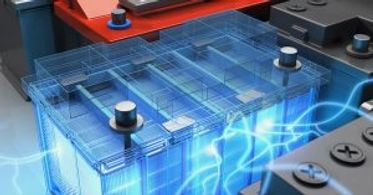May the force be with you - Battery Considerations for UPS Solutions
Selecting the battery system deployed with a UPS solution is a significant consideration. With larger UPS systems, the battery can contribute up to 50% of the cost and 100% of the back up power.
1. Engineering Design
Good UPS and battery system design is vital and ensures that the power quality solution deployed will deliver at the crucial time when it is needed. It is important to define how much power will be required and for how long (battery runtime)
Critical applications require the battery to keep the load running for extended power breaks, while others just need enough autonomy to allow critical loads to shut down gracefully, or for a generator to start up and deliver its supply.
A basic battery arrangement comprises a string of blocks connected in series. Increased capacity is achieved by deploying multiple strings in parallel. The overall battery voltage is the sum of the individual block voltages, and must match the UPS’s float voltage setting.
2. Battery Technology
Batteries are available in a range of technologies including lead-acid, nickel-cadmium, lithium-ion and more. Of all the technologies available, lead-acid remains the most popular choice and is deployed in over 99% of all UPS applications due to the cost, availability and proven performance.
Lead-acid batteries come in multiple form factors, the most common being maintenance free valve-regulate-lead-acid (VRLA).
The VRLA form factor is the most common for UPS applications for a variety of reasons:
- Cost – VRLA technology can be one of the most cost-effective battery solutions.
- Sealed construction – The VRLA cell is typically sealed so that it does not release gas during normal operation. The battery case does have a valve that can open and release gas under fault conditions.
- Reduced maintenance – As the cell is sealed and any gasses created during the electrolysis process are recombined inside the battery it is not necessary to add liquid to the electrolyte.
- Immobilised electrolyte – There is no free-flowing electrolyte in VRLA batteries.
- Flexible deployment – Because the battery block contains no liquid electrolyte, the blocks can be installed in any orientation.
VRLA does present some considerations and trade-offs worth noting:
- Low temperature tolerances – High ambient temperatures can accelerate the evaporation of the electrolyte leading to premature failure of the battery block.
- Design/Service life – Depending on the block selected, design life is 5 to 10 years.
Lithium-Ion technology is currently generating a lot of interest in the market, however the uptake for this technology has not yet been significant. There are some identified benefits to Lithium-Ion when compared to VRLA technology. These include increased power density (more power in a smaller foot print and weight), increased design/service life and faster recharge time, however there are also some trade-offs which include a significant cost delta and an unproven technology in larger blocks over the claimed design life.
3. Quality
All batteries are not created equal, so be sure to select a quality product specified to your application. There are many battery manufacturers in the market and it can be hard to identify the good from the bad, though there are some key indicators of quality such as:
- The use of pure lead in the manufacturing process instead of recycled lead that may be of a variable quality. Recycled lead might have mixed-metal contamination, which degrades both performance and shortens overall service life.
- Manufacturer warranty statements provide confidence that they stand behind their product.
- Published battery discharge curves and specifications indicate a quality manufacturer. These organisations will always publish their discharge specifications to show that their batteries have been correctly tested.
- Quality control testing in factory with ISO certification.
4. Product Stewardship
The carbon footprint of a battery must be factored into the impact on the environment throughout the life cycle of the battery from manufacture to disposal. Available evidence suggests that the carbon footprint of a lithium-ion battery is nearly the same as lead-acid when a manufacture to disposal view is considered. Factoring in environmental considerations such as, the manufacturers environmental accreditation and systems during the decision to purchase is important.
5. Safety
Battery systems contain a significant amount of stored energy and must be treated with respect.
Quality battery manufacturers provide a Material Safety Data Sheet (MSDS) for their battery products which provides information on the correct handling and storage of the battery blocks.
It pays to invest in specialist design, quality products, installation, monitoring and services for your battery systems. This ensures that they are well engineered for your requirements and safe for your site.
Batteries not performing either due to failure or incorrect system design are too often the cause of UPS systems failing to provide power when required.
To ensure your battery solution will deliver the sufficient autonomy or backup time your system requires, you must choose quality battery products as well as engage expert design assistance to understand the expected run-time required for your operation.
These decisions coupled with regular maintenance and pro-active monitoring of your battery system will also mitigate the risk of outages and ensure that battery health is maintained throughout the service life of the battery solution.

